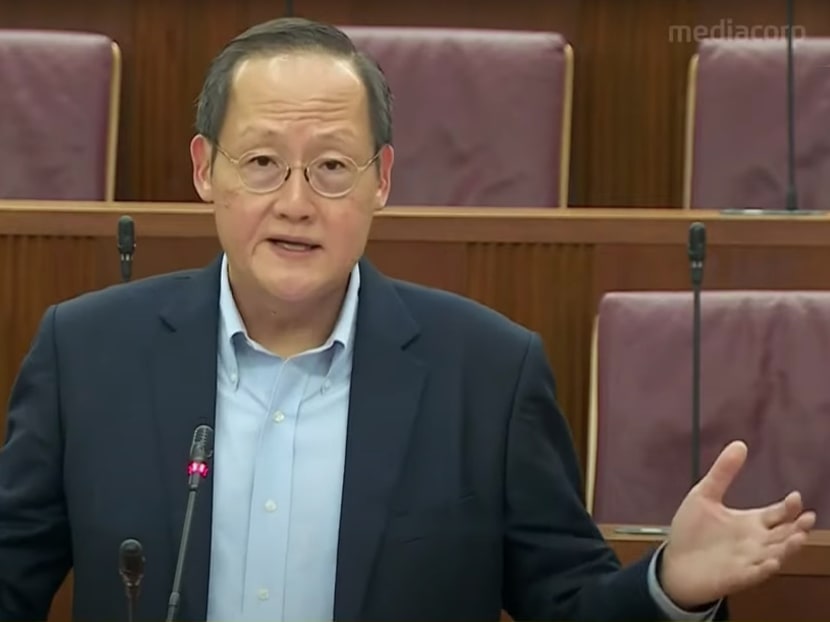WP's alternatives to GST increase ‘unsustainable’, will burden middle-income earners: Tan See Leng
SINGAPORE — The proposal put forward by the Workers’ Party (WP) as an alternative to the upcoming hike in Goods and Services Tax (GST) is unsustainable, and would over time result in a bigger burden on the middle and upper-middle income earners, said Minister for Manpower Dr Tan See Leng in Parliament on Tuesday (Mar 1).

Dr Tan See Leng, Minister for Manpower, speaking at a parliamentary debate on the Budget on March 1, 2022.
- WP's proposed alternatives to the upcoming GST hike is not sustainable, Manpower Minister Tan See Leng said
- Its proposal, which includes higher taxes on the wealthy, will result in a bigger burden on middle-income earners
- Leader of Opposition Pritam Singh and other WP members said taxing the rich was but one of four parts of the party’s proposal
- Mr Singh said WP’s plans were not meant to be punitive on the rich, but sought to be more equitable
SINGAPORE — The proposal put forward by the Workers’ Party (WP) as an alternative to an upcoming increase in Goods and Services Tax (GST) is not sustainable and will result in a bigger burden on the middle-income- and upper-middle-income earners, Manpower Minister Tan See Leng said.
Speaking in Parliament on Tuesday (March 1) during the second day of a debate on this year’s Budget, Dr Tan said: “They (WP Members of Parliament) oppose the Budget because of the GST increase, but they agree with the moves we (the Government) are making to shore up social compact.
“They accept greater government spending. In fact, they would like us to spend even more. I believe their position is: Agree with all the good and nice things we propose; say not enough; ask for more.”
At the same time, the opposition party was being “relatively muted” about the consequences of its proposals on the wider society, Dr Tan added.
WP chief Pritam Singh, along with his party members, responded by saying that their alternative proposal did not call for punitive taxes on the wealthy, but merely an equitable society.
Mr Singh, who is Leader of the Opposition, also described the minister’s “understanding” of WP’s proposals as “incorrect”.
‘RICH SHOULD CARRY HEAVIER BURDEN’
The GST will go up from 7 per cent to 8 per cent next year, and then to 9 per cent in 2024.
In his speech, Dr Tan stressed that the Government’s approach to the Budget is that the rich should carry a heavier load.
He drew attention to the various tax changes announced during the Budget statement on Feb 18 that would affect the high-income earners.
These announcements were:
- More income tax for people in the highest-income brackets
- A two-step increase in property tax
- A new tier for the Additional Registration Fee for luxury cars
“The well-off will pay more and receive less. And the less well-off will receive more and pay less,” Dr Tan said, repeating it again for emphasis.
“It is not possible to get the entire GST amount, the S$3.5 billion, by loading it all on just those at the very top.Manpower Minister Tan See Leng on why the Government cannot further tax the rich beyond what it announced in Budget 2022”
On WP’s suggestion to increase personal income tax and property tax even further, Dr Tan said that it will result in more people paying more.
This is because it is not possible or fair to have “extremely punitive taxes on just the top 1 per cent or 5 per cent” income earners.
“It is not possible to get the entire GST amount, the S$3.5 billion, by loading it all on just those at the very top,” he said.
The Government will then have to make more people, including middle-income earners, pay more. It will have to raise income taxes for not just those at the very top, but it will "pervade and percolate down, to the middle-income and upper-middle-income”, Dr Tan added.
These will include those who have toiled and worked very hard all through the years to move up from more modest circumstances.
“It will ultimately result in a system where our approach to revenue is just to squeeze anyone who does well, from the middle-income upwards.”
He added that the Government “fundamentally disagrees” with the impact of WP’s proposals on the society, adding that it will not be good for Singapore’s social compact.
‘EQUITABLE, NOT PUNITIVE’
In response, Mr Singh, who is a Member of Parliament (MP) for the Aljunied Group Representation Constituency (GRC), said that the point of his party’s proposal was to achieve a more equitable load, not a punitive tax on the wealthy.
“How do you balance things in a manner that is more equitable for society going forward, for a more fair, more sustainable and more inclusive society? I think that’s the thrust of what the Workers’ Party had put forward,” he said.
“In the spirit of seeking a more equitable tax distribution among various segments of the society, I think the Workers’ Party is fully entitled to raise alternate forms of revenue, which we have. So I disagree with the minister’s characterisation.”
Fellow WP MP Jamus Lim also spoke to highlight that his party’s proposals consisted of four levers, of which one was described as a wealth tax lever.
Three other “levers” that WP had suggested the day before in Parliament, as alternative means to increase revenue for the Government, were corporate tax, reserves contribution (referring to the Net Investment Returns Contribution or NIRC) and an externalities lever, which entailed imposing higher taxes on the likes of gambling, alcohol and tobacco.
Associate Professor Lim, MP of Sengkang GRC, emphasised that the party’s proposal sought “as much as possible to spread the revenue schemes in as broad a manner as possible”, while having a certain degree of fairness and equity.
Mr Singh later stood again to put on record that “the understanding that (Dr Tan) had of WP’s alternate proposals is incorrect”.
“In the spirit of seeking a more equitable tax distribution among various segments of the society, I think the Workers’ Party is fully entitled to raise alternate forms of revenue, which we have.Mr Pritam Singh, Leader of the Opposition”
During the exchanges with Dr Tan, WP also took issue with the minimum income criterion of S$500 for someone to receive support under the Workfare Income Supplement Scheme, which is intended to aid older low-wage workers.
They said that there may be various reasons impeding someone from working full-time and earning the required wage qualification.
Mr Zaqy Mohamad, Senior Minister of State for Manpower, clarified that the qualifying salary was meant to differentiate between low-income earners and part-time workers who may not come from low-income households.
He added that workers who are beneficiaries of ComCare, a social assistance scheme for low-income individuals and families, will automatically receive Workfare support as well, regardless of their income level.
In a subsequent speech, Mr Xie Yao Quan from the ruling People’s Action Party and MP for Jurong GRC, also responded to one of WP’s suggestions.
He argued that the GST ought to be the “first resort” mechanism adjusted before looking at other sources of revenue such as the NIRC, which now stands at 50 per cent.
Mr Leon Perera, WP MP for Aljunied GRC, asked if there was “anything magical” or a “special methodology” behind the current 50 per cent cap of the NIRC, such that it cannot be adjusted to provide more revenue for the Government.
To this, Mr Xie replied that it was a matter of judgement, and it was his own view that the 50-50 split of the NIRC is the “right mix”.
The NIRC allows the Government to spend up to 50 per cent of the net investment returns on net assets invested by Singapore's sovereign wealth fund GIC, the Monetary Authority of Singapore and state investor Temasek Holdings — the three entities that manage and invest Singapore's reserves — and up to 50 per cent of the net investment income derived from past reserves from the remaining assets.
In other words, half of the estimated gains from investment is spent and the other half is put back into the reserves to preserve its growth for future use.








